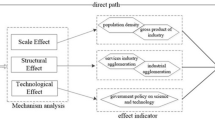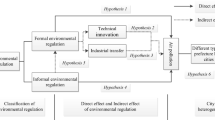Abstract
Environmental regulation is considered an important means to solve PM2.5 pollution. Based on panel data of 280 cities in China from 2003 to 2016, this paper analyzes the dual effects of environmental regulation on PM2.5 pollution, namely, the direct effect and the indirect effect by three transmission channels of the technological innovation, industrial structure, and foreign direct investment (FDI). The impact of urban heterogeneity on the effects of environmental regulation is then examined. The study found that environmental regulation has a significant negative impact on PM2.5 pollution. In addition, environmental regulation can indirectly reduce PM2.5 pollution through technological innovation and industrial structure adjustment. However, it also restrains the environmental spillover effect of FDI, in this way exacerbating PM2.5 pollution. Urban heterogeneity factors such as geographical location, city size, and resource endowment have an impact on pollution control and the haze reduction effect of environmental regulation. Finally, based on the research conclusion, some suggestions are proposed for strengthening environmental regulation and reducing PM2.5 pollution.

Similar content being viewed by others
Data availability
The datasets used or analyzed during the current study are available from the corresponding author on reasonable request.
References
Bigazzi AY, Figliozzi MA (2012) Congestion and emissions mitigation: a comparison of capacity, demand, and vehicle-based strategies. Transport Res D-Tr E 17:538–547
Cai HB, Chen YY, Gong Q (2016a) Polluting thy neighbor: unintended consequences of China’s pollution reduction mandates. J Environ Econ Manag 76:86–104
Cai XQ, Lu Y, Wu MQ, Yu LH (2016b) Does environmental regulation drive away inbound foreign direct investment? Evidence from a quasi-natural experiment in China. J Dev Econ 123:73–85
Cai X, Zhu BZ, Zhang HJ, Li L, Xie MY (2020) Can direct environmental regulation promote green technology innovation in heavily polluting industries? Evidence from Chinese listed companies. Sci Total Environ 746:140810
Cao Y, Wan NN, Zhang HY, Zhang XL, Zhou Q (2020) Linking environmental regulation and economic growth through technological innovation and resource consumption: analysis of spatial interaction patterns of urban agglomerations. Ecol Indic 112:106062
Chen X, Qian WW (2020) Effect of marine environmental regulation on the industrial structure adjustment of manufacturing industry: an empirical analysis of China’s eleven coastal provinces. Mar Policy 113:103797
Cheng ZH, Li LS, Liu J (2017) The emissions reduction effect and technical progress effect of environmental regulation policy tools. J Clean Prod 149:191–205
Dou JM, Han X (2019) How does the industry mobility affect pollution industry transfer in China: empirical test on pollution haven hypothesis and Porter hypothesis. J Clean Prod 217:105–115
Du WJ, Li MJ (2020) Influence of environmental regulation on promoting the low-carbon transformation of China’s foreign trade: based on the dual margin of export enterprise. J Clean Prod 244:118687
Elliott RJR, Zhou Y (2013) Environmental regulation induced foreign direct investment. Environ Resour Econ 55:141–158
Faiz A (1993) Automotive emissions in developing countries-relative implications for global warming, acidification and urban air quality. Transport Res A-Pol 27:167–186
Feng T, Du HB, Lin ZG, Zuo J (2020) Spatial spillover effects of environmental regulations on air pollution: evidence from urban agglomerations in China. J Environ Manag 272:110998
Geng CX, Cui ZY (2020) Analysis of spatial heterogeneity and driving factors of capital allocation efficiency in energy conservation and environmental protection industry under environmental regulation. Energy Policy 137:111081
Hao Y, Liu YM (2016) The influential factors of urban PM2.5 concentrations in china: a spatial econometric analysis. J Clean Prod 112:1443–1453
Hao Y, Deng YX, Lu ZN, Chen H (2018) Is environmental regulation effective in China? Evidence from city-level panel data. J Clean Prod 188:966–976
Hassaballa H (2014) Testing for Granger causality between energy use and foreign direct investment Inflows in developing countries. Renew Sust Energ Rev 31:417–426
Hou J, Teo TSH, Zhou FL, Lim MK, Chen H (2018) Does industrial green transformation successfully facilitate a decrease in carbon intensity in China? An environmental regulation perspective. J Clean Prod 184:1060–1071
Jin H, Qian XY, Chin T, Zhang HJ (2020) A global assessment of sustainable development based on modification of the human development index via the entropy method. Sustainability 12:3251
Lanoie P, Patry M, Lajeunesse R (2008) Environmental regulation and productivity: testing the Porter hypothesis. J Prod Anal 30:121–128
Li C (2019) How does environmental regulation affect different approaches of technical progress? Evidence from China’s industrial sectors from 2005 to 2015. J Clean Prod 209:572–580
List JA, McHone WW, Millimet DL (2003) Effects of air quality regulation on the destination choice of relocating plants. Oxf Econ Pap 55:657–678
Liu WS, Liu Y, Lin BQ (2018) Empirical analysis on energy rebound effect from the perspective of technological progressed case study of China’s transport sector. J Clean Prod 205:1082–1093
Liu XR, Sun T, Feng Q, Zhang D (2020) Dynamic environmental regulation threshold effect of technical progress on China’s environmental pollution. J Clean Prod 272:122780
Millimet DL, Roy J (2016) Empirical tests of the pollution haven hypothesis when environmental regulation is endogenous. J Appl Econ 31:652–677
Ngo NS, Zhong N, Bao X (2018) The effects of transboundary air pollution following major events in China on air quality in the U.S.: evidence from Chinese New Year and sandstorms. J Environ Manag 212:169–175
Nocera S, Maino F, Cavallaro F (2012) A heuristic Method for evaluating CO2 efficiency in transport planning. Eur Transp Res Rev 4:91–106
Nocera S, Cavallaro F, Irranca Galati O (2018) Options for reducing external costs from freight transport along the Brenner corridor. Eur Transp Res Rev 10:53
Orun A, Elizondo D, GoodyervE PD (2018) Use of Bayesian inference method to model vehicular air pollution in local urban areas. Transport Res D-Tr E 63:236–243
Ouyang XL, Li Q, Du KR (2020) How does environmental regulation promote technological innovations in the industrial sector? Evidence from Chinese provincial panel data. Energy Policy 139:111310
Pan XF, Ai BW, Li CY, Pan XY, Yan YB (2019) Dynamic relationship among environmental regulation, technological innovation and energy efficiency based on large scale provincial panel data in China. Technol Forecast Soc Change 144:428–435
Ramanathan R, Black A, Nath P, Muyldermans L (2010) Impact of environmental regulations on innovation and performance in the UK industrial sector. Manag Decis 48:1493–1513
Ramanathan R, Ramanathan U, Bentley YM (2018) The debate on flexibility of environmental regulations, innovation capabilities and financial performance-A novel use of DEA. Omega 75:131–138
Song ML, Wang SH, Sun J (2018) Environmental regulations, staff quality, green technology, R&D efficiency, and profit in manufacturing. Technol Forecast Soc Change 133:1–14
Sun CW, Zhang F, Xu ML (2017) Investigation of pollution haven hypothesis for China: an ARDL approach with breakpoint unit root tests. J Clean Prod 161:153–164
Tian RQ, Shao QL, Wu FL (2020) Four-dimensional evaluation and forecasting of marine carrying capacity in China: empirical analysis based on the entropy method and grey Verhulst model. Mar Pollut Bull 160:111675
Wan QZ, Yu Y (2020) Power load pattern recognition algorithm based on characteristic index dimension reduction and improved entropy weight method. Energy Rep 6:797–806
Wang MX, Wang HP (2021) Spatial distribution patterns and influencing factors of PM2.5 pollution in the Yangtze River Delta: Empirical analysis based on a GWR model. Asia-Pac J Atmos Sci 57:63–75
Wang JS, Chan TL, Ning Z, Leung CW, Cheung CS, Hung WT (2006) Roadside measurement and prediction of CO and PM2.5 dispersion from on-road vehicles in Hong Kong. Transport Res D-Tr E 11:242–249
Wang JY, Wang S, Li SJ (2019) Examining the spatially varying effects of factors on PM2.5 concentrations in Chinese cities using geographically weighted regression modeling. Environ Pollut 248:792–803
Yang QY, Song DY (2019) How does environmental regulation break the resource curse: Theoretical and empirical study on China. Res Policy 64:101480
Yi M, Wang YQ, Sheng MY, Sharp B, Zhang Y (2020) Effects of heterogeneous technological progress on haze pollution: Evidence from China. Ecol Econ 169:106533
Yu X, Li Y (2020) Effect of environmental regulation policy tools on the quality of foreign direct investment: An empirical study of China. J Clean Prod 270:122346
Yu X, Wang P (2021) Economic effects analysis of environmental regulation policy in the process of industrial structure upgrading: Evidence from Chinese provincial panel data. Sci Total Environ 753:142004
Zhang Y, Wang JR, Xue YJ, Yang J (2018) Impact of environmental regulations on green technological innovative behavior: An empirical study in China. J Clean Prod 188:763–773
Zhang M, Liu XX, Ding YT, Wang WW (2019) How does environmental regulation affect haze pollution governance? An empirical test based on Chinese provincial panel data. Sci Total Environ 695:133905
Zhang M, Sun XR, Wang WW (2020) Study on the effect of environmental regulations and industrial structure on haze pollution in China from the dual perspective of independence and linkage. J Clean Prod 256:120748
Zhou XX, Feng C (2017) The impact of environmental regulation on fossil energy consumption in China: direct and indirect effects. J Clean Prod 142:3174–3183
Zhou Q, Zhang XL, Shao QL, Wang XL (2019) The non-linear effect of environmental regulation on haze pollution: empirical evidence for 277 Chinese cities during 2002-2010. J Environ Manag 248:109274
Zhou Q, Song YN, Wan NN, Zhang XL (2020) Non-linear effects of environmental regulation and innovation: spatial interaction evidence from the Yangtze River Delta in China. Environ Sci Pol 114:263–274
Zhou Q, Zhong SH, Shi T, Zhang XL (2021) Environmental regulation and haze pollution: neighbor-companion or neighbor-beggar? Energy Policy 151:112183
Zhu WW, Wang MC, Zhang BB (2019) The effects of urbanization on PM2.5 concentrations in China’s Yangtze River Economic Belt: new evidence from spatial econometric analysis. J Clean. Prod 239:118065
Funding
This research was funded by the National Natural Science Foundation of China for Young Scholars(No.71603202), the Shaanxi Soft Science Foundation (No.2019KRM129), the Shaanxi Province Education Department Philosophy and Social Science Key Institute Base Project (No. 19JZ048), the Shaanxi University Youth Innovation Team Project (Shaanjiao [2019] No.90), the Scientific Research Project of China (Xi’an) Institute for Silk Road Research (No. 2019YA08), and the Start-up Funds for Doctoral Research in Xi’an University of Technology (No. 105-256081503).
Author information
Authors and Affiliations
Contributions
All authors contributed to the study conception and design. Material preparation, data collection, and analysis were performed by Huiping Wang and Jiaxin Li. The first draft of the manuscript was written by Huiping Wang. All authors read and approved the final manuscript.
Corresponding author
Ethics declarations
Conflict of interest
The authors declare no competing interests.
Additional information
Responsible Editor: Ilhan Ozturk
Publisher’s note
Springer Nature remains neutral with regard to jurisdictional claims in published maps and institutional affiliations.
Rights and permissions
About this article
Cite this article
Wang, H., Li, J. Dual effects of environmental regulation on PM2.5 pollution: evidence from 280 cities in China. Environ Sci Pollut Res 28, 47213–47226 (2021). https://doi.org/10.1007/s11356-021-14011-4
Received:
Accepted:
Published:
Issue Date:
DOI: https://doi.org/10.1007/s11356-021-14011-4




